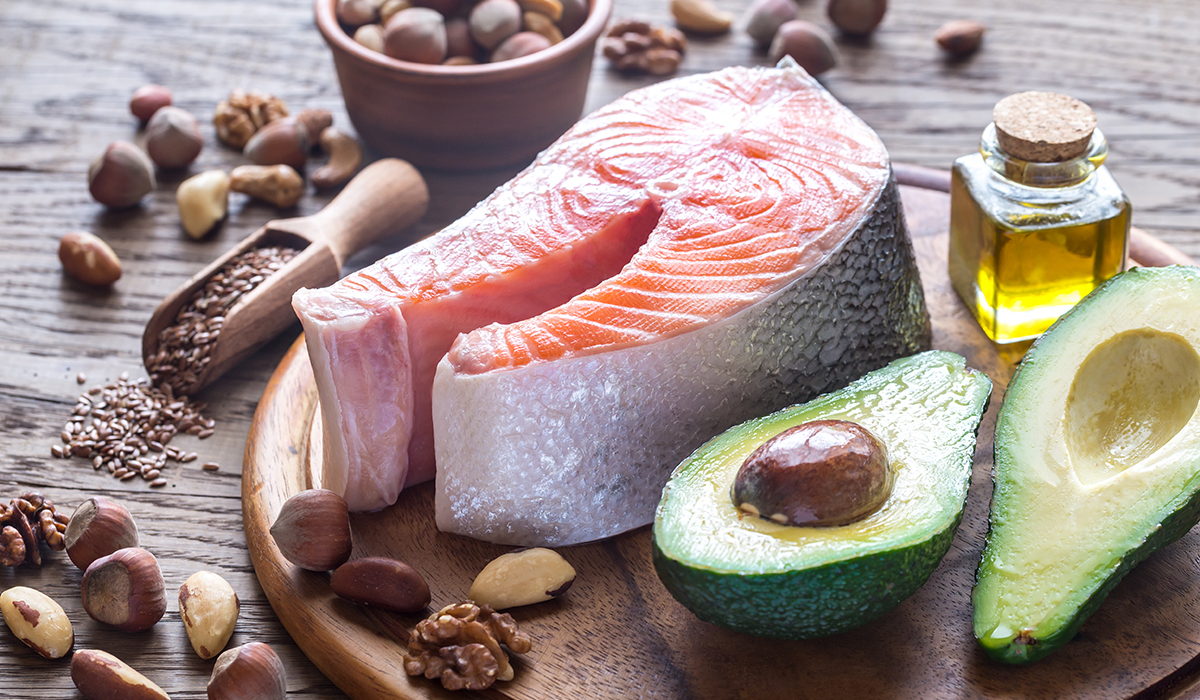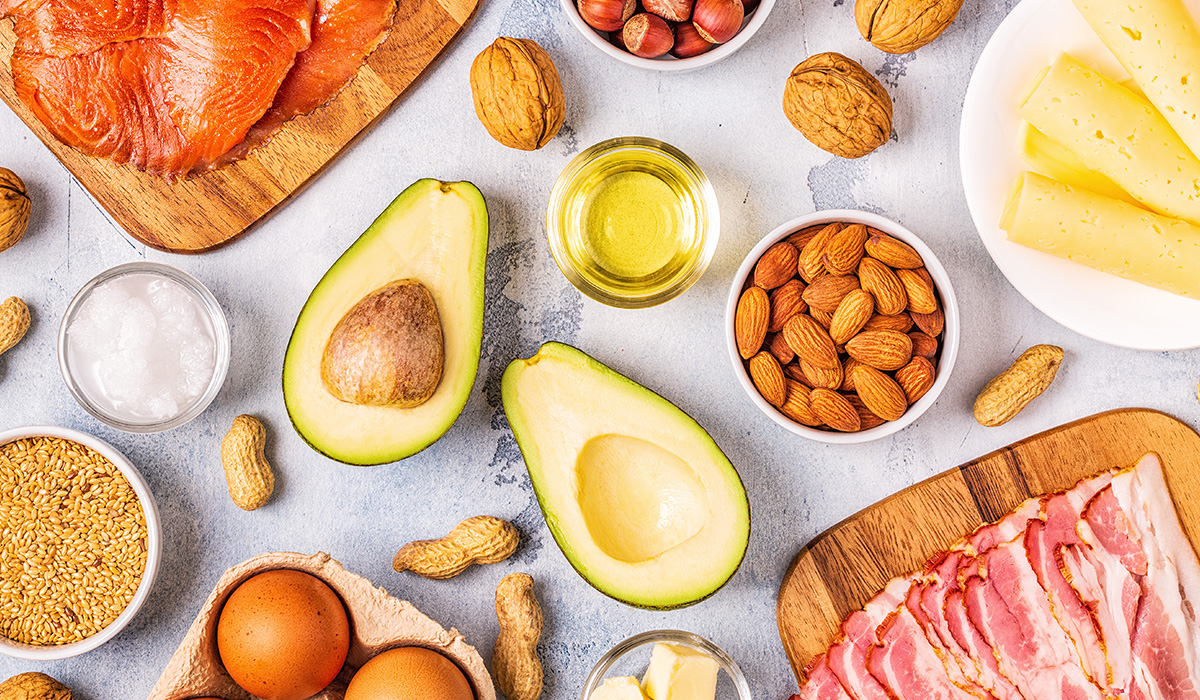If you find yourself in a conversation about dieting or weight loss, chances are you’ll hear of the ketogenic, or keto, diet. That’s because the keto diet has become one of the most popular methods worldwide to shed excess weight and improve health.
Research has demonstrated that adopting this low-carb, high-fat diet can promote fat loss and even improve certain conditions such as type 2 diabetes and cognitive decline.
KETOGENIC DIET BASICS
The keto diet is very low in carbs, high in fat and moderate in protein. When following a ketogenic diet, carbs are typically reduced to 20 to 50 grams per day, though looser versions of the diet exist. Fats should replace most of the carbs and deliver approximately 75% of your total calorie intake. Proteins should account for around 10-30% of energy needs, while carbs are usually restricted to 5%. This carb reduction forces your body to rely on fats for its main energy source instead of glucose — a process known as ketosis. While in ketosis, your body uses ketones — molecules produced in the liver from fats when glucose is limited — as an alternate fuel source.
During ketosis, your body converts fat into compounds known as ketones and begins using them as its main source of energy.
Some research suggests that ketosis may be helpful for type 2 diabetes and neurological disorders, among other conditions. Achieving a state of ketosis can take some work and planning, it is not just as simple as cutting carbs.
BENEFITS OF THE KETO / LOW CARB DIET
LOW-CARB DIETS REDUCE YOUR APPETITE
Hunger tends to be the worst side effect of dieting. It is one of the main reasons why many people feel miserable and eventually give up. However, low-carb eating leads to an automatic reduction in appetite when in ketosis. Studies consistently show that when people cut carbs and eat more protein and fat, they end up eating far fewer calories.
LOW-CARB DIETS CAN LEAD TO MORE WEIGHT LOSS
Cutting carbs is one of the simplest and most effective ways to lose weight.
Studies illustrate that people on low-carb diets lose more weight, faster, than those on low-fat diets — even when the latter are actively restricting calories. This is because low-carb diets act to rid excess water from your body, lowering insulin levels and leading to rapid weight loss in the first week or two.
In studies comparing low-carb and low-fat diets, people restricting their carbs sometimes lose 2–3 times as much weight — without being hungry.
In a year-long study in 609 overweight adults on low- fat or low-carb diets, both groups lost similar amounts of weight.
A GREATER PROPORTION OF FAT LOSS COMES FROM YOUR ABDOMEN
Not all fat in your body is the same. Where fat is stored determines how it affects your health and risk of disease.
The two main types are subcutaneous fat, which is under your skin, and visceral fat, which accumulates in your abdominal cavity and is typical for most overweight men.
Visceral fat tends to lodge around your organs. Excess visceral fat is associated with inflammation and insulin resistance — and may drive the metabolic dysfunction.
Low-carb diets are remarkably effective at reducing this harmful abdominal fat. In fact, a greater proportion of the fat people lose on low-carb diets seems to come from the abdominal cavity. Over time, this should lead to a drastically reduced risk of heart disease and type 2 diabetes.
TRIGLYCERIDES DROP DRASTICALLY
Triglycerides are fat molecules that circulate in your bloodstream. It is well known that high fasting triglycerides — levels in the blood after an overnight fast – are a strong heart disease risk factor. One of the main drivers of elevated triglycerides in sedentary people is carb consumption — especially the simple sugar fructose. When people cut carbs, they tend to experience a very dramatic reduction in blood triglycerides. On the other hand, low-fat diets often cause triglycerides to increase.
INCREASED LEVELS OF ‘GOOD’ HDL CHOLESTEROL
High-density lipoprotein (HDL) is often called the “good” cholesterol. The higher your levels of HDL relative to “bad” LDL, the lower your risk of heart disease. One of the best ways to increase “good” HDL levels is to eat good fat. Low-carb diets usually include a lot of fat. Therefore, it is unsurprising that HDL levels increase dramatically on healthy, low-carb diets, while they tend to increase only moderately or even decline on low-fat diets.
REDUCED BLOOD SUGAR AND INSULIN LEVELS
Low-carb and ketogenic diets can also be particularly helpful for people with diabetes and insulin resistance, which affect millions of people worldwide.
Studies prove that cutting carbs lowers both blood sugar and insulin levels drastically. Some people with diabetes who begin a low-carb diet may need to reduce their insulin dosage by 50% almost immediately.
In one study in people with type 2 diabetes, 95% had reduced or eliminated their glucose-lowering medication within six months.
If you take blood sugar medication, talk to your doctor before making changes to your carb intake, as your dosage may need to be adjusted to prevent hypoglycaemia.
MAY LOWER BLOOD PRESSURE
Elevated blood pressure, or hypertension, is a significant risk factor for many diseases, including heart disease, stroke, and kidney failure.
Low-carb diets are an effective way to lower blood pressure, which should reduce your risk of these diseases and help you live longer.
EFFECTIVE AGAINST METABOLIC SYNDROME
Metabolic syndrome is a condition highly associated with your risk of diabetes and heart disease. In fact, metabolic syndrome is a collection of symptoms, which include:
- Abdominal obesity
- Elevated blood pressure
- Elevated fasting blood sugar levels
- High triglycerides
- Low “good” HDL cholesterol levels
However, a low-carb diet is incredibly effective in treating all five of these symptoms. Under such a diet, these conditions are nearly eliminated.
IMPROVED ‘BAD’ LDL CHOLESTEROL LEVELS
People who have high “bad” LDL are much more likely to have heart attacks. However, the size of the particles is important. Smaller particles are linked to a higher risk of heart disease, while larger particles are linked to a lower risk.
It turns out that low-carb diets increase the size of “bad” LDL particles while reducing the number of total LDL particles in your bloodstream. As such, lowering your carb intake can boost your heart health.
THERAPEUTIC FOR SEVERAL BRAIN DISORDERS
Your brain needs glucose, as some parts of it can only burn this type of sugar. That is why your liver produces glucose from protein if you do not eat any carbs. Yet, a large part of your brain can also burn ketones, which are formed during starvation or when carb intake is incredibly low.
This is the mechanism behind the ketogenic diet, which has been used for decades to treat epilepsy in children who do not respond to drug treatment.
In many cases, this diet can cure children of epilepsy. In one study, over half of the children on a ketogenic diet experienced a greater than 50% reduction in their number of seizures, while 16% became seizure-free.
Very low-carb and ketogenic diets are now being studied for other brain conditions as well, including Alzheimer’s and Parkinson’s disease.
IS KETOSIS SAFE AND DOES IT HAVE SIDE EFFECTS?
A ketogenic diet induces a state called ketosis. This is different from ketoacidosis, a serious condition that can happen when a person is unable to manage diabetes. Ketosis is safe for most people, especially if they follow it with a doctor’s supervision. However, it can have some negative effects, especially at the start. It is also unclear how a ketogenic diet may affect the body long term.
THE LOW CARB/KETO FLU
In the beginning of ketosis, you may experience a range of negative symptoms. People often call these the “low carb flu” or “keto flu” because they resemble symptoms of the flu. These may include:
- Headache
- Fatigue
- Brain fog
- Increased hunger
- Poor sleep
- Nausea
- Decreased physical performance.
These issues may discourage people from continuing to follow a ketogenic diet before they start noticing the benefits. However, the “low carb flu” is usually over within a few days.
BAD BREATH IS ALSO COMMON
One of the more common side effects of ketosis is bad breath, often described as fruity and slightly sweet. It is caused by acetone, a ketone that is a by-product of fat metabolism. Blood acetone levels rise during ketosis, and your body gets rid of some of it via your breath. Occasionally, sweat and urine can also start to smell like acetone. Acetone has a distinctive smell — it is the chemical that gives nail polish remover its pungent odour. For most people, this unusual-smelling breath will go away within a few weeks.
LEG MUSCLES MAY CRAMP
In ketosis, some people may experience leg cramps. These can be painful, and they can be a sign that you need to drink more water. Leg cramps in ketosis usually stem from dehydration and loss of minerals. This is because ketosis causes a reduction in water weight.
Glycogen, the storage form of glucose in muscles and liver, binds water.
This gets flushed out when you reduce carb intake. It is one of the main reasons why people lose weight
rapidly in the first week of a low carb diet.
It is important to continue to drink plenty of water to reduce the risk of dehydration, changes in electrolyte balance, and kidney problems.
KETOSIS MAY CAUSE DIGESTIVE PROBLEMS
Dietary changes can sometimes lead to digestive issues. This is also true for ketogenic diets, and constipation is a common side effect in the beginning.
This is most commonly due to not eating enough fibre and not drinking enough fluids. Some people may also get diarrhoea, but it is less common.
If the switch to a keto diet dramatically changes the way you eat, you are more likely to have digestive symptoms.
Nevertheless, digestive issues are usually over within a few weeks.
ELEVATED HEART RATE
Some people also experience increased heart rate as a side effect of ketosis. This is also called heart palpitations or a racing heart. It can happen during the first few weeks of a ketogenic diet.
Being dehydrated is a common cause, as well as low salt intake. Drinking a lot of coffee might also contribute to this. If the problem does not stop, you might need to increase your carb intake.
OTHER SIDE EFFECTS OF KETOSIS
Other, less common side effects may include:
- KETOACIDOSIS: A few cases of ketoacidosis (a serious condition that occurs in diabetes when it is not effectively managed) have been reported in breastfeeding women, triggered by a low carb diet. However, this is rare
- KIDNEY STONES: Although uncommon, some children with epilepsy have developed kidney stones on a ketogenic diet. Experts recommend regular monitoring while following the diet
- RAISED CHOLESTEROL LEVELS: Some people get increased total and LDL (bad) cholesterol levels
- FATTY LIVER: This can develop if you follow the diet for a long time
- HYPOGLYCAEMIA: If you use medications to manage your blood sugar levels, speak to a doctor before starting the diet, as they may need to adjust the dose
Some of the negative effects, such as dehydration and low blood sugar can lead to emergency room visits. The keto diet is not suitable for people with conditions, including:
- Pancreatitis
- Liver failure
- Carnitine deficiency
- Porphyria
- Disorders that affect the way their body processes fat
HOW TO MINIMIZE POTENTIAL SIDE EFFECTS
Here is how to minimize the potential side effects of ketosis:
- DRINK PLENTY OF WATER. Consume at least 2 litres of water a day. A significant amount of weight lost in ketosis is water, especially in the beginning
- GET ENOUGH SALT. The body excretes sodium in copious amounts when carb intake is low. Ask your doctor if you should be adding salt to your food.
- INCREASE MINERAL INTAKE. Food’s high in magnesium and potassium may help relieve leg cramps
- AVOID INTENSE EXERCISE. Stick to moderate levels of exercise in the first week or two
- TRY A LOW CARB DIET FIRST. This might help you reduce your carbs to a moderate amount before moving onto a ketogenic (low carb) diet
- EAT FIBRE. A low carb diet is not a no-carb one. Ketosis typically starts when your carb intake is less than 50 grams a day. Eat fibre-rich foods like nuts, seeds, berries, and low carb veggies
KETOGENIC DIET MEAL PLAN
Switching over to a ketogenic diet can seem overwhelming, but it does not have to be difficult. Your focus should be on reducing carbs while increasing the fat and protein content of meals and snacks. To reach and remain in a state of ketosis, carbs must be restricted.
While certain people might only achieve ketosis by eating 20 grams of carbs per day, others may be successful with a much higher carb intake. The lower your carbohydrate intake, the easier it is to reach and stay in ketosis.
Therefore, sticking to keto-friendly foods and avoiding items rich in carbs is the best way to successfully lose weight on a ketogenic diet.
KETO-FRIENDLY FOODS TO EAT
When following a ketogenic diet, meals and snacks should centre around the following foods:
- EGGS: Pastured, organic whole eggs make the best choice
- POULTRY: Chicken and turkey
- FATTY FISH: Wild-caught salmon, herring, and mackerel
- MEAT: Grass-fed beef, venison, pork, organ meats and bison
- FULL-FAT DAIRY: Yogurt, butter, and cream
- FULL- FAT CHEESE: Cheddar, mozzarella, brie, goat cheese and cream cheese
- NUTS AND SEEDS: Macadamia nuts, almonds, walnuts, pumpkin seeds, peanuts, and flaxseeds
- NUT BUTTER: Natural peanut, almond, and cashew butters
- HEALTHY FATS: Coconut oil, olive oil, avocado oil, coconut butter and sesame oil
- AVOCADOS: Whole avocados can be added to almost any meal or snack
- NON-STARCHY VEGETABLES: Greens, broccoli, tomatoes, mushrooms, and peppers
- CONDIMENTS: Salt, pepper, vinegar, lemon juice, fresh herbs, and spices
KETO-FRIENDLY BEVERAGES
Sugar can be found in a wide variety of beverages including juice, soda, iced tea, and coffee drinks. While on a ketogenic diet, high-carb drinks must be avoided just like high-carb foods. Sugary beverages have also been linked to various negative health issues — from obesity to an increased risk of diabetes. Thankfully, there are many tasty, sugar-free options for those on the keto diet. Keto-friendly beverage choices include:
- WATER: Water is the best choice for hydration and should be consumed throughout the day
- SPARKLING WATER: Sparkling water can make an excellent soda replacement
- UNSWEETENED COFFEE: Try heavy cream to add flavour to your cup
- UNSWEETENED GREEN TEA: green tea is delicious and provides many health benefits
If you want to add some extra flavour to your water, try experimenting with different keto-friendly flavour combinations. For example, tossing some fresh mint and lemon peel into your water bottle can make hydration a breeze.
Alcohol should be restricted while following the Keto diet.
FOODS TO AVOID
Avoid foods rich in carbs while following a keto diet. The following foods should be restricted:
- BREAD AND BAKED GOODS: White bread, whole-wheat bread, crackers, cookies, doughnuts, and rolls
- SWEETS AND SUGARY FOODS: Sugar, ice cream, candy, maple syrup, agave syrup and coconut sugar
- SWEETENED BEVERAGES: Soda, juice, sweetened teas, and sports drinks
- PASTA: Spaghetti and noodlesGRAINS AND GRAIN PRODUCTS: Wheat, rice, oats, breakfast cereals and tortillas
- STARCHY VEGETABLES: Potatoes, sweet potatoes, butternut squash, corn, peas, and pumpkinBEANS AND LEGUMES: Black beans, chickpeas, lentils, and kidney beans
- FRUIT: Citrus, grapes, bananas, and pineapple
- HIGH-CARB SAUCES: Barbecue sauce, sugary salad dressings and dipping sauces
- CERTAIN ALCOHOLIC BEVERAGES: Beer and sugary mixed drinks
Though carbs should be restricted, low-glycaemic fruits such as berries can be enjoyed in limited amounts if you are maintaining a keto-friendly macronutrient range.
Be sure to choose healthy food sources and avoid processed foods and unhealthy fats. The following items should be avoided:
- UNHEALTHY FATS: Margarine, shortening and vegetable oils such as canola and corn oil
- PROCESSED FOODS: Fast food, packaged foods, and processed meats such as hot dogs and lunch meats
- DIET FOODS: Foods that contain artificial colours, preservatives, and sweeteners such as sugar alcohols and aspartame
SAMPLE KETO MENU FOR ONE WEEK
The following menu provides less than 50 grams of total carbs per day. Some people may have to reduce carbohydrates even further to reach ketosis.
This is a general one-week ketogenic menu that can be altered depending on individual dietary needs.
MONDAY
- BREAKFAST: Two eggs fried in pastured butter served with sauteed greens
- LUNCH: A bun-less grass-fed burger topped with cheese, mushrooms, and avocado atop a bed of greens
- DINNER: Pork chops with green beans sauteed in coconut oil
TUESDAY
- BREAKFAST: Mushroom omelette
- LUNCH: Tuna salad with celery and tomato atop a bed of greens
- DINNER: Roast chicken with cream sauce and sauteed broccoli
WEDNESDAY
- BREAKFAST: Bell pepper stuffed with cheese and eggs
- LUNCH: Arugula salad with hard-boiled eggs, turkey, avocado, and blue cheese
- DINNER: Grilled salmon with spinach sauteed in coconut oil
THURSDAY
- BREAKFAST: Full-fat yogurt topped with Keto granola
- LUNCH: Steak bowl with cauliflower rice, cheese, herbs, avocado, and salsa
- DINNER: Bison steak with cheesy broccoli
FRIDAY
- BREAKFAST: Baked avocado egg boats
- LUNCH: Caesar salad with chicken
- DINNER: Pork chops with vegetables
SATURDAY
- BREAKFAST: Cauliflower toast topped with cheese and avocado
- LUNCH: Salmon burger topped with pesto
- DINNER: Meatballs served with zucchini noodles and parmesan cheese
SUNDAY
- BREAKFAST: Coconut milk chia pudding topped with coconut and walnuts
- LUNCH: Cobb salad made with greens, hard-boiled eggs, avocado, cheese, and turkey
- DINNER: Coconut chicken curry
HEALTHY KETOGENIC SNACK OPTIONS
Snacking between meals can help moderate hunger and keep you on track while following a ketogenic diet.
Because the ketogenic diet is so filling, you may only need one or two snacks per day, depending on your activity level. Here are some excellent, keto-friendly snack options:
- Almonds and cheddar cheese
- Half an avocado stuffed with chicken salad
- Guacamole with low-carb veggies
- Trail mix made with unsweetened coconut, nuts, and seeds
- Hard-boiled eggs
- Coconut chips
- Kale chips
- Olives and sliced salami
- Celery and peppers with herbed cream cheese dip
- Berries with heavy whipping cream
- Jerky
- Cheese roll-ups
- Parmesan crisps
- Macadamia nuts
- Greens with high-fat dressing and avocado
- Keto smoothie made with coconut milk, cocoa, and avocado
- Avocado cocoa mousse
Though these keto snacks can maintain fullness between meals, they can also contribute to weight gain if you are snacking too much throughout the day. It is important to eat the appropriate number of calories based on your activity level, weight loss goal, age, and gender.
A SIMPLE KETOGENIC SHOPPING LIST
A well-rounded ketogenic diet should include lots of fresh produce, healthy fats, and proteins.
Choosing a mixture of both fresh and frozen produce will ensure that you have a supply of keto-friendly vegetables and fruits to add to recipes.
The following is a simple ketogenic shopping list that can guide you when perusing the grocery aisles:
- MEAT AND POULTRY: Beef, chicken, turkey, and pork (choose organic, pasture-raised options whenever possible)
- FISH: Fatty fish like salmon, sardines, mackerel, and herring are best
- SHELLFISH: Oysters, shrimp, and scallops
- EGGS: Purchase omega-3-enriched or pastured eggs whenever possible
- FULL-FAT DAIRY: Unsweetened yogurt, butter, heavy cream, and sour cream
- OILS: Coconut and avocado oils
- AVOCADOS: Buy a mixture of ripe and unripe avocados so that your supply will last
- CHEESE: Brie, cream cheese, cheddar, and goat cheese.
- FROZEN OR FRESH BERRIES: Blueberries, raspberries, blackberries
- NUTS: Macadamia nuts, almonds, pecans, pistachios
- SEEDS: Pumpkin seeds, sunflower seeds, chia seeds
- NUT BUTTERS: Almond butter, peanut butter
- FRESH OR FROZEN LOW-CARB
- VEGETABLES: Mushrooms, cauliflower, broccoli, greens, peppers, onions, and tomatoes
- CONDIMENTS: Sea salt, pepper, salsa, herbs, garlic, vinegar, mustard, olives, and spices
It is always worthwhile to plan your meals ahead of time and fill your cart with the ingredients needed for a few days’ worth of healthy dishes. Plus, sticking to a shopping list can help you avoid tempting, unhealthy foods.
THE BOTTOM LINE
A healthy ketogenic diet should consist of about 75% fat, 10-30% protein and no more than 5% or 20 to 50 grams of carbs per day.
Focus on high-fat, low-carb foods like eggs, meats, dairy, and low-carb vegetables, as well as sugar-free beverages. Be sure to restrict highly processed items and unhealthy fats. The popularity of the ketogenic diet has made it easier than ever to find a wide array of interesting and healthy keto meal ideas online. Using these notes as a guide to get you started on the keto diet can set you up for success and make transitioning to a high-fat, low-carb diet a breeze.







